In a recent post, Greg highlighted the JW Marriott Masai Mara and a plethora of award availability between September 2023 and June 2024. In his post he talks about why he’s excited about the property, but also has this to say about a potential downside of the property:
Getting to the property isn’t easy. From Nairobi, it looks like the best option is to take a bush plane.
This comment reminded me of one of my favorite misadventures from my days spent traveling in that luxury-meets-broke-backpacker style that Drew and I still have to some degree, but embodied even more entirely in our 20’s. Admittedly…this story is way more “broke backpacker” than “luxury”, but I wonder if some of you will be able to relate as you think back to your own 20-something-misadventures.
The story starts with a Toyota Rav 4 rented by walking around Nairobi asking strangers for a car
Sometimes I think that our travel style hasn’t changed all that much over the years…until I remember that we landed with a group of 3 other friends in Nairobi with a reservation the next night in Masai Mara and no rental car reservation whatsoever. Instead, we spent our first morning in Kenya walking around the neighborhood asking people for a 4WD to rent. This may sound like a really impractical tactic, but there’s a large portion of the world where this kind of thing can actually work well – and sure enough, soon Drew was surrounded by locals all calling their friends/cousins/uncles with rental businesses of one kind or another. Surely there were commissions to be earned and who’s to say if we got ripped off or not, but within an hour or so, we ended up with a $65/day rate for 6 days for a 2008 Toyota Rav 4. We were happy with that.
The road from Nairobi to Masai Mara National Reserve…could be worse
The road to Masai Mara could be better and could be worse. The driving can feel hectic, and you’ll encounter pot holes, unmarked speed bumps, and security checkpoints with intimidating spike strips…(sometimes with only the spike strips and no security.) At the time we visited in 2015, this road was paved until about the last 100 miles, where it became more rocky and rugged. It took us 6 hours to reach Keekorok Lodge, 2 hours longer than Google’s time estimate. Not the worst road we’ve ever navigated though…(which came later that week.)
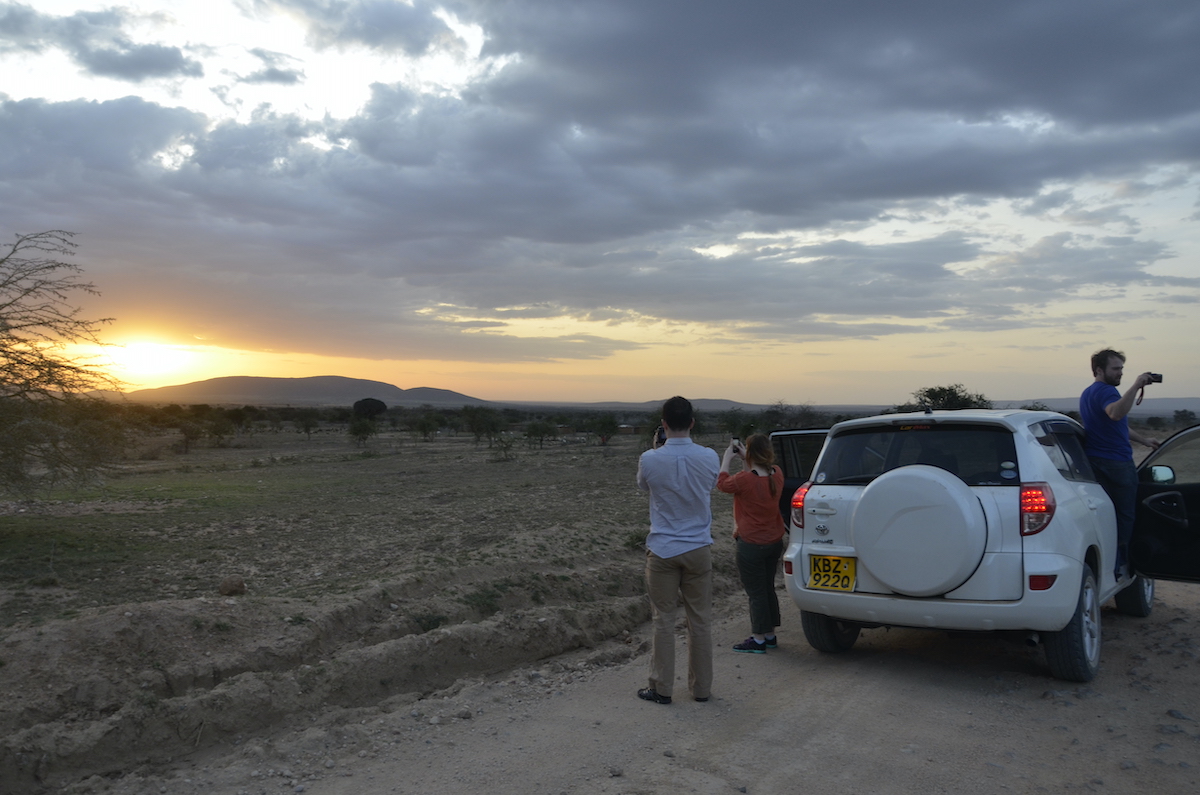
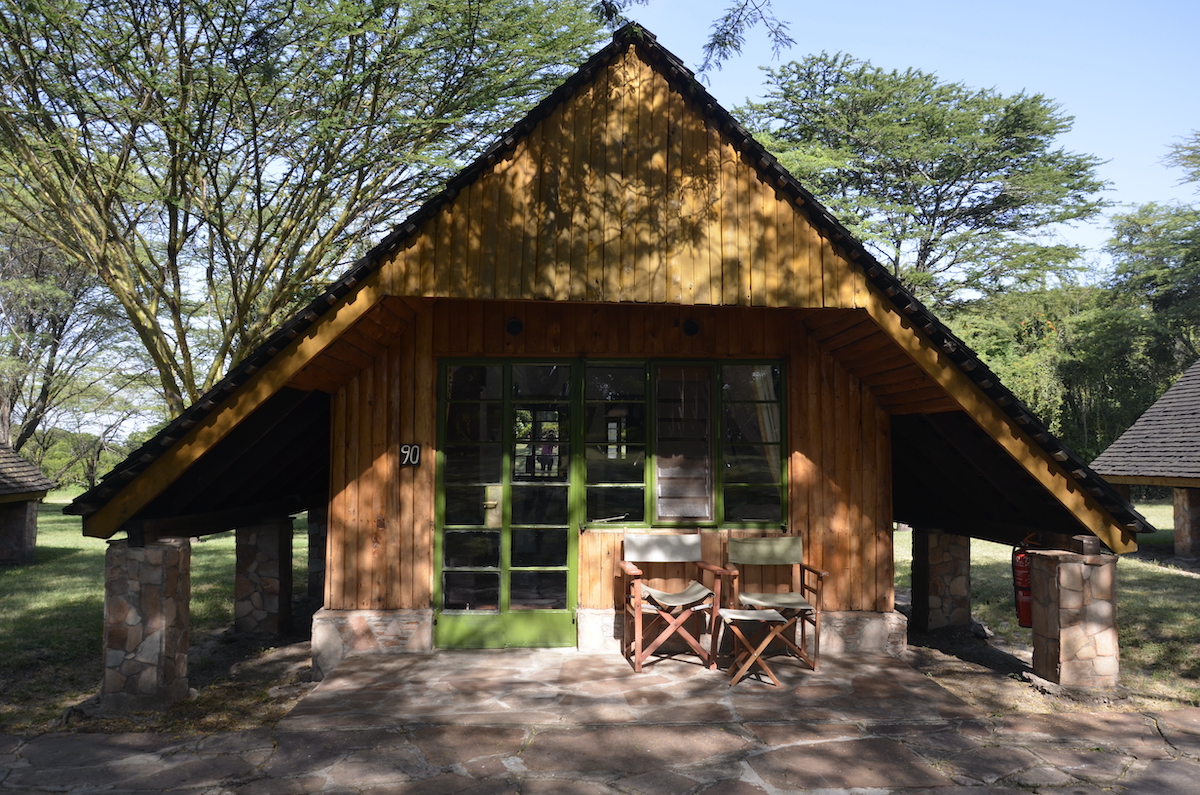
Masai Mara is worth it, and actually quite do-able with our Toyota Rav 4
Amazingly, the Toyota Rav 4 ended up being a perfectly suitable vehicle for our self-drive safari and our visit to Masai Mara and the Keekorok Lodge is still one of the highlights of my life. We could literally hear the strange half-bark-half-roar of a little family of lions outside of the property fence in the middle of the night and we could see the hippos out on the lawn outside. Being immersed in a place this wild was an unforgettable experience.
And we had a fair amount of success with our safari outings each morning and evening as well. We saw a cheetah attempt to chase down an antelope, we saw a mama lion and her cubs, hyenas, zebras, elephants…it was incredible.
On our final morning, we hired a local Masai guide named Josh Lepapa to join us and take us to any hot spots we may have missed. (He was extremely friendly and still works as a guide – you can find him on Instagram as @masai_mara_guide if you’re interested in scheduling him as a guide for your own visits.)
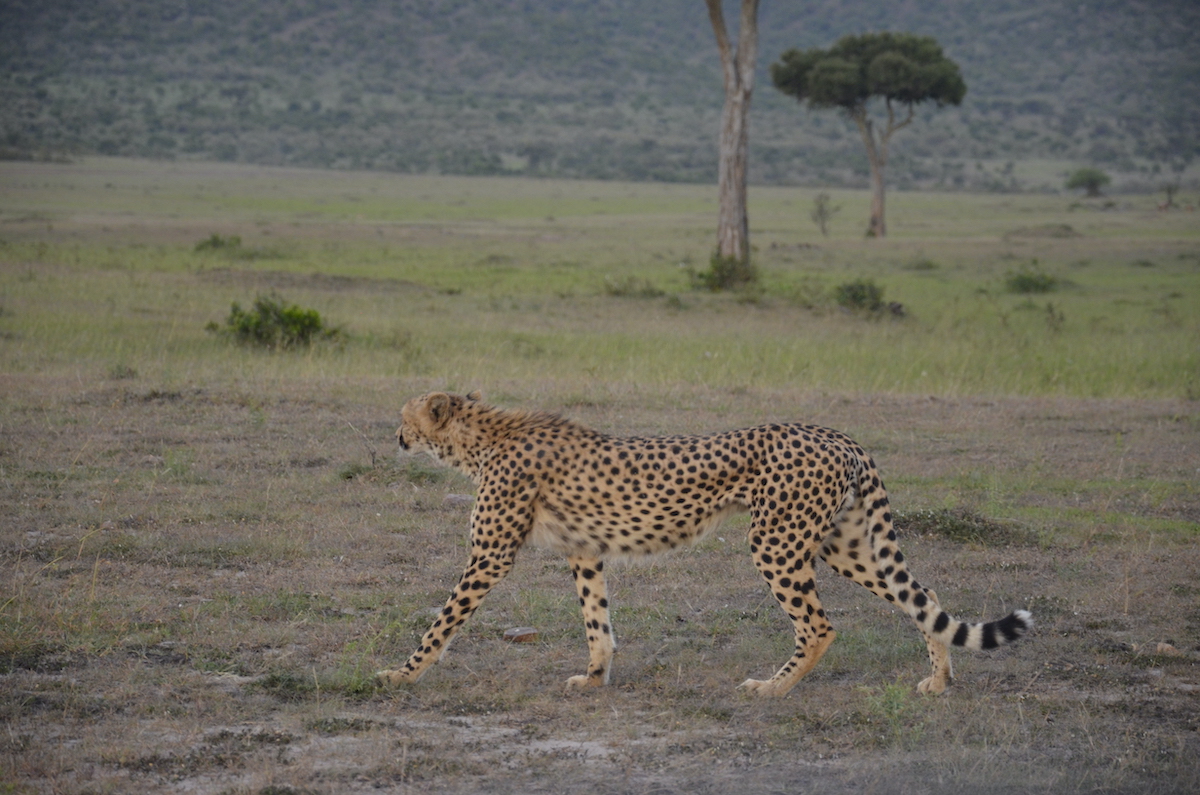
Leaving Masai Mara is where the trouble began…
Once we left Masai Mara, this is where we encountered the real challenges, in part because we were not driving directly back to Nairobi – we were driving onward to Lake Nakuru and ultimately Lake Naivasha. We had not seen any rhinos in Masai Mara and we were told that Lake Naivasha was the perfect place to see them. (That turned out to be true.)
Soon after leaving Masai Mara, we picked up a local hitch-hiker named Moses. (Hitch hiking is extremely common in the remote parts of Kenya.) About 20 minutes into Moses’ ride with us, we heard a sound and sure enough, one of those giant rocks in the road had finally got us. This hardly felt like bad luck so much as an inevitability, but we were relieved that the Rav had a real tire as its spare. In no time we were back on the road.
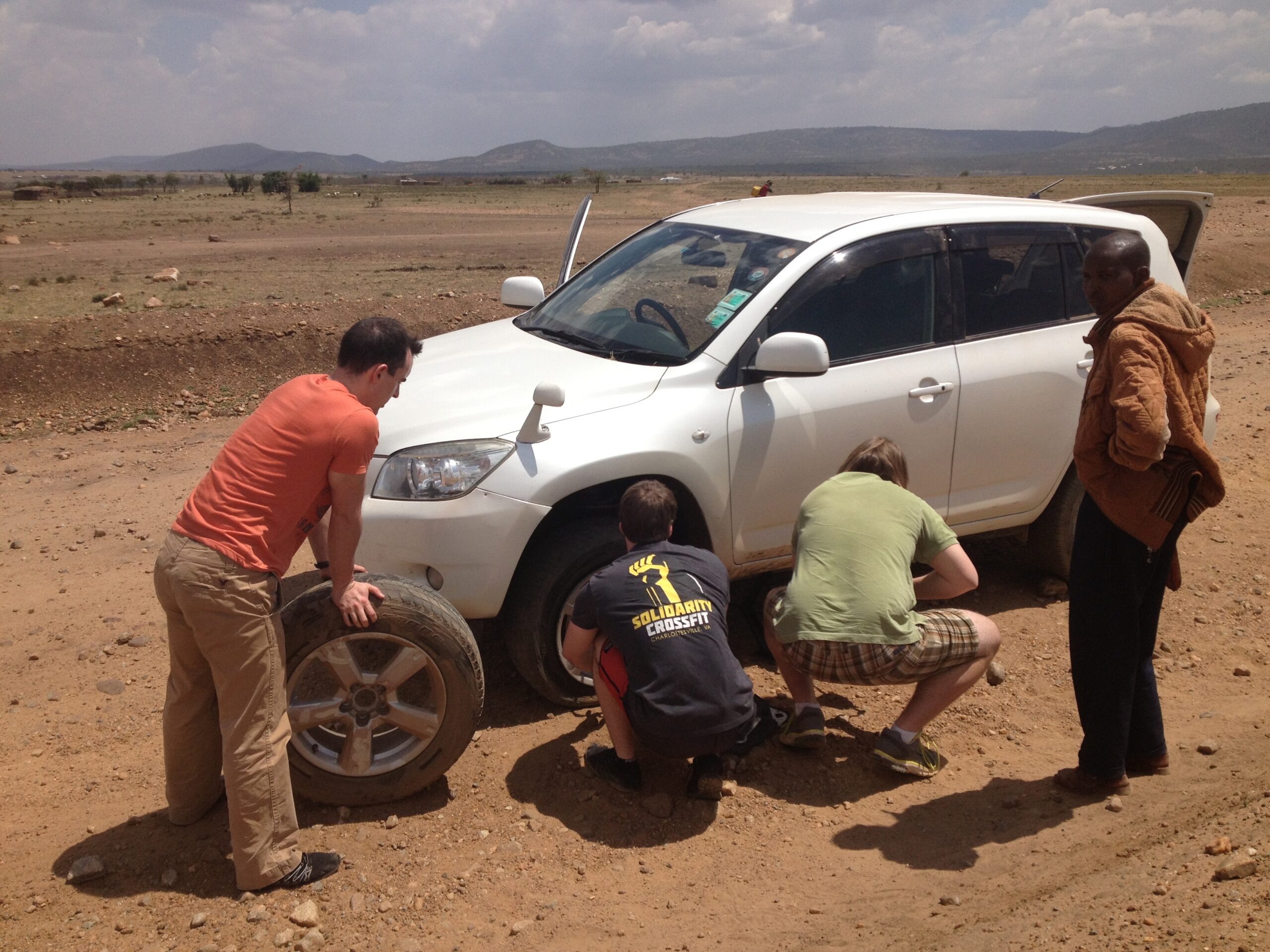
If he didn’t already regret hitching a ride with us, the second flat tire probably did the trick.
We’d all taken the first flat tire in stride, even Moses, but by the time we hit the second sharp rock, I think I saw him roll his eyes and sigh.
Now we were all stranded in the middle of nowhere with no more spare tires.
I’ll give you a moment to think through the solutions available to us. There’s really only one option. We would have to become hitch-hikers ourselves.
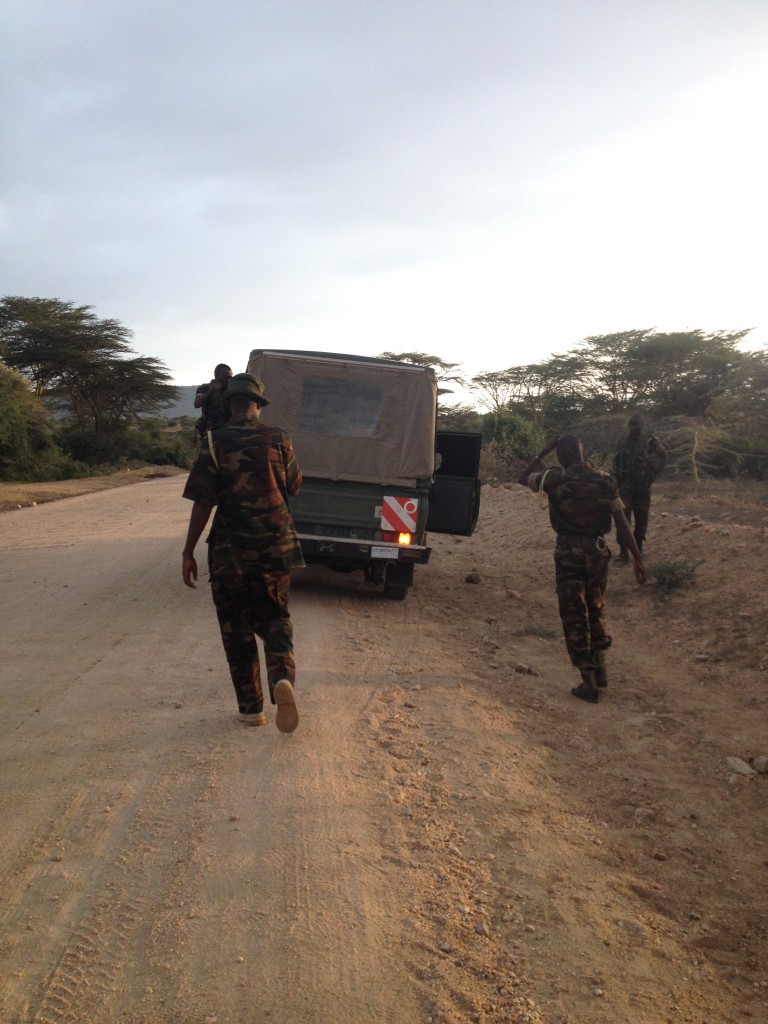
We decided it was best to split up – send 2 people hitch-hiking to the nearest town slightly more than an hour away to find a place that would either sell us a new tire or patch the existing one and leave the rest of us to watch over the Rav.
We were not left to debate this plan long before a huge military truck pulled up and offered to give our designated hitchers a ride to Narok, the next town down the road. Our friend Daniel (one of the designated hitchers) says that he’s still not sure if they were already heading to Narok anyway or if they reorganized their original plans around our situation. Either way, they saved the day for us (and Moses as well, as he finally made his way out of our inept hands.)
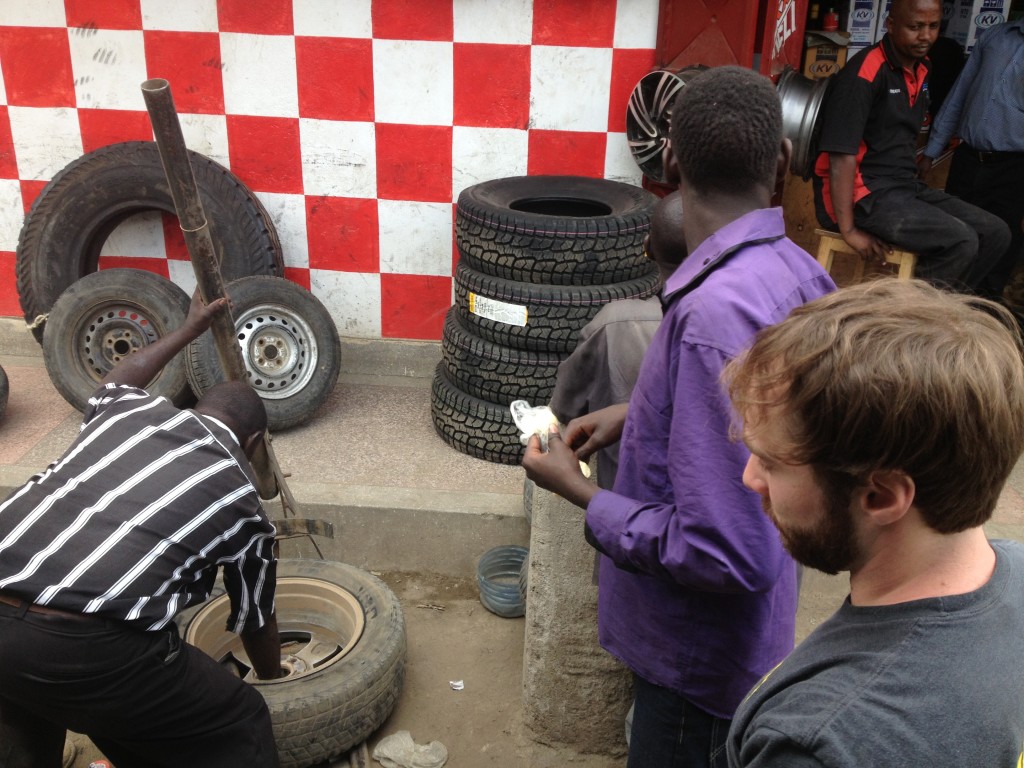
Those of us who stayed back with the Rav didn’t know the day had been saved yet, though. All we knew was that two of our friends had just jumped into the back of a military truck with hopes of reaching a tire repair shop. We spent the first hour and a half goofing off with a local boy who’d come to see what the fuss was. We attempted to learn how he whistled complex melodies through his fingers but we never got the hang of it and eventually he went home and left us to sit by ourselves for another 2 hours wondering if our friends were still ok.
Right around the 3.5 hour mark, the very same military truck came ambling down the road with our friends safe and sound, and a new tire as well. We were elated and I still wonder if the folks who picked our friends up even had any occasion to go to Narok or if they were purely just helping us out.
We hadn’t seen the worst roads yet
I don’t remember much from Lake Nakuru other than being relieved to get there that night…and the absolutely atrocious roads we were about to encounter on our way from there to Lake Naivasha the next day.
Drew and I didn’t have a phone plan at that time – just someone’s old unlocked iPhone -and our friends didn’t have plans with international data, so we were using an offline map called Maps.Me.
It’s hard to tell from a digital map how drivable a road is when it’s just a little line on a screen. Some of it was ordinary enough, but as the evening stretched on, the rocks got bigger and the pot holes deeper. It felt a bit like the story of the frog in the water, not realizing the temperature rising a degree at a time until he’s boiling. By the time we realized how undeveloped the route we’d selected was, we were at that awful decision point where you can’t decide if it’s worse to go back through all the harrowing terrain you just finished or go forward and hope to God the condition improves ahead. We played that “should we turn around or keep going” game for probably 2 hours until it was dark. All the while the ghosts of yesterday’s busted tires were haunting us.
According to the GPS we were only a mile away from the main road but, the distance we’d just traveled was probably not all that long in miles either, so this was only so concerting. Not only were the conditions like the surface of the moon at this point, but the boundary of the road was getting very hard to decipher and we’d found ourselves in at least one dead end. With a particularly un-road-like patch ahead of us, we amazingly saw the first human we’d seen in hours, so we rolled down our window to ask him if this was indeed a road.
As it turns out, the conditions had got the best of him too. He’d been riding a bike and cart and had tipped it to the point of ruining it. Lucky for all of us, his buddies had just arrived to help him. They tried to help us push the Rav up that final craggy ridge but it was impassable. Thankfully, they knew an adjoining road we could take not too far back.
With this new road to follow, our luck started improving and we finally made it off the surface of the moon and back onto the main road. We found a bar that was still serving food despite the late hour and we ate it in exhaustion as we listened to a playlist that un-ironically included Rick Astley’s “Never Gonna Give You Up.” It suited the moment somehow perfectly.
Lake Naivasha was a beautiful way to end the trip, and we did indeed see literal tons of rhinos.
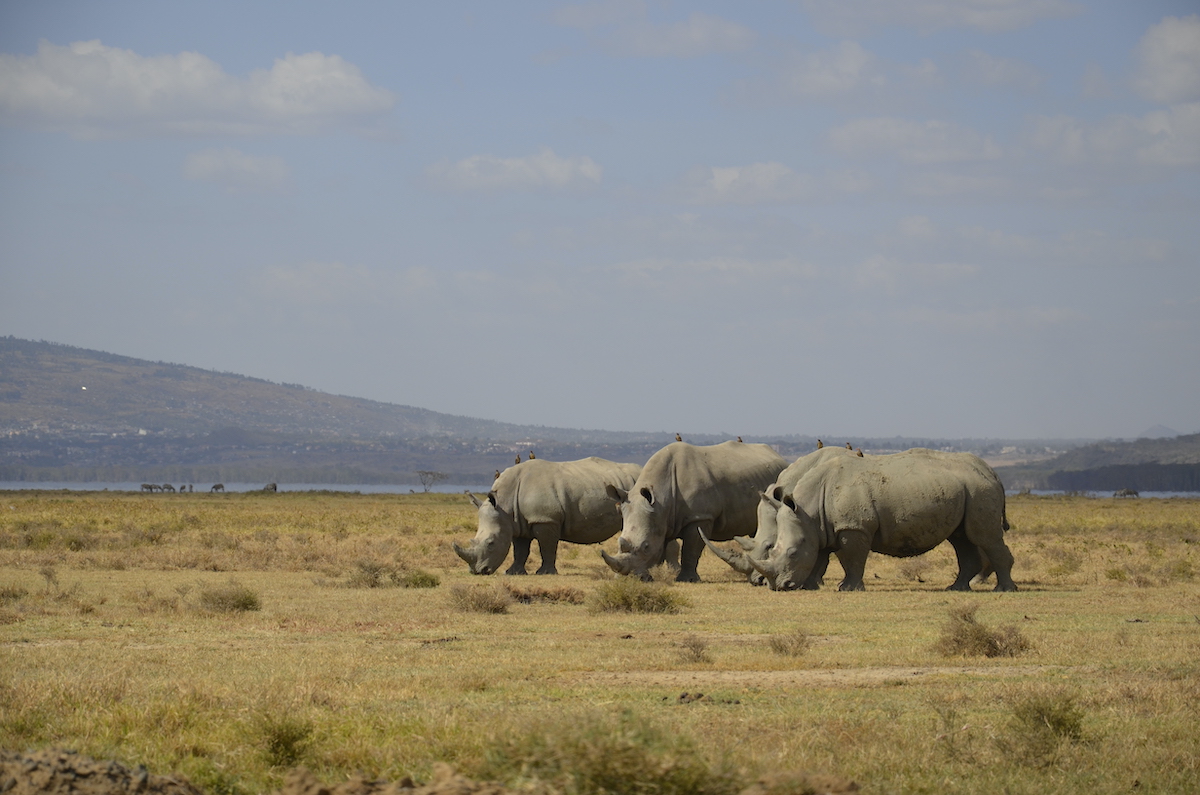
Could we have avoided all this?
Of course we could have avoided all this with a beefier vehicle than the humble Rav 4, a second spare tire, and a data plan so we could access a more trustworthy map like Google Maps. In other words…I don’t know if we would have nearly the trouble today we had back then, just by being a little less shoe-string about things. But on the other hand, I’ve heard safari stories from others that sound not so unlike this one.
So now I’m curious to hear from all of you – has anyone else driven to Masai Mara? If so, what was your experience?


Such a great story. When Greg posted and then I booked 7 nights at the JW, I first looked at the road trip on google maps. I prefer driving when possible as I think that’s part of the fun of traveling. I still need to do more research, but your story is an inspiration that it’s at least possible.
Fun story: hakuna matata.
I made that drive in the early ‘80’s, in a Toyota sedan, with my wife and toddler son. It meant driving through herds of wildebeests and hanging on the side of huge flooded potholes, hoping they weren’t too deep. At one point near Eldoret, we landed in a huge dust crater, with dust everywhere, inside and out. The car died, I thought we were done. To my surprise, the Toyota started right up and off we went. On the way back from the camp, we gave a ride to one of the workers, who directed us across the Masai Mara, visiting with local Masai and seeing galloping giraffes along the way. Even though it was 40 years ago, I still remember the whole experience vividly.
when we went to Namibia Etosha in Oct 2019 we asked Avis for 2 spare ties. They looked at us like we were crazy. They said you needed to call weeks in advance to reserve.
The roads were pretty bad and we thought we had one flat. Turned out it was a false alarm. But we definitely heard people had flat tires with no one in sight for many miles.
There is a great article at Adventure.com about the Disneyfication of Africa. Well worth the read if you are planning a trip, and some thought provoking ideas about the types of things you might want to consider adding to your safari itinerary.
Similar experience 11 years ago trying to go to the arctic circle on Dalton Highway. It’s where’d “ice road truckers” is filmed and in winter it’s iced over. Sumner is angular sharp rocks and our National car rental struggled once we lost the pavement. Stranded overnight after first flat and a can of tire fix in a “motel” 60 miles from nowhere, but they fired up the grill at midnight and with disk approaching we enjoyed burgers and met a large group of worldwide motorcyclists enroute from a “pole to pole” excursion ride- Deadhorse, AK to Argentina. Next morning with a scheduled afternoon flight from Fairbanks, we didn’t try and make it to the arctic circle, and headed back to Fairbanks – and got another flat. A AK DOT truck came along and told us to try to get to their yard 25 miles away where the pavement started again. We rode about 10pm on the flat, and a DOT worker at the hard gave us a ride into Fairbanks where we just made our flight. Dropped the keys to the National desk with a picture and location of the car. An unforgettable experience.
WOW! What an experience!
For sure, National was upset when I dropped the keys at the terminal. They forgot to ask me to sign the waiver at time of rental about taking the vehicle off-road.
Whoops!!! 🙂
I was in Kenya a few months ago for business.
I flew in to Nairobi and had a connecting flight to Kisumu and from there drive to Kericho.
I stayed there for 2 days and when it was time to go back to the airport the guys I was visiting told me they would not let me go back to Kisumu. Reason: it was just after the elections and they had just announced the final results.
Kericho was in a district of the winning Party and Kisumu in a district of the losing Party. they were scared of riots.
They decided to send me with a driver directly to Nairobi Airport. Approx. 200 KM.
Over 5 hours drive! Really bad roads and big potholes and “highways” with slowing bumps…
Omg. You are brave. I’ll be taking that flight!! Lol
Not Kenya, but back in the day (1991) my (now) wife and I drove the Plenty “highway”, hundreds of miles through the remote Australian outback on a dirt road, ocassionally dissolving into multiple, undifferentiated tracks. We did this in a 1968 Ford Falcon station wagon with a spare, two jerrycans of gasoline, and three other backpackers we’d picked up at hostels in Alice Springs.
We decided to do this by asking everyone in Alice Springs if it would be okay to drive that road in our station wagon. They all said “You’d be mad, mate”, until one person (I think behind the counter in a donut shop) said “Don’t see why not!” So off we went.
Much of the road was heavily potholed, but bull dust (kind of like quicksand) would fill in the potholes so you couldn’t see them coming. On the second day we hit a pothole and the car dropped six inches with a giant thud. No obvious damage to the tires (we’d already used the spare), so we drove on.
At our lunch stop, someone said “hey, what’s that” pointing at a steady stream of liquid coming from the bottom of the car. It turns out a rock in the pothole had pierced the gas tank, which was now “peeing” out gasoline. It’s very hard to stop this kind of leak because nothing sticks to a surface that has gas on it. We eventuallly stopped it up with soap, part of a handkerchief, and duct tape.
With that we were able to limp onwards to a stop that night at the “most remote pub in Australia” (which is saying a lot — it was still 60 miles to the nearest paved road) where everybody knew exactly how to handle this. You remove some rubber gasket from around the door, take a screw (from the dashboard, if you don’t have a spare one), stuff the gash with the rubber and drive the screw through it to hold it in place. Fortunately, our jury-rigged repair held until the next day when we were able to reach on autosupply shop and buy some metal epoxy to repair the hole.
I heard recently that they’re going to pave the Plenty highway, which seems a shame to me.
Seems a shame indeed!
WOW! I can’t imagine I’d be creative enough to think of patching with soap OR the rubber gasket from around the door. I’ll have to try and remember that (though hopefully I’ll never need to use it!)
In August 2012, I spent seven days in Kenya. Our transportation and lodging was handled by a local tour operator. We departed for the Great Rift Valley from Nairobi in their Land Rover, there were six of us and a driver.We spent one night visiting the Lipton Tea Plantation in Kericho. We then spent two nights at the Sarova Lion Hill Game Lodge at Lake Nakuru. We spent three nights at the Sarova Mara Game Camp located in the Maasai Mara National Reserve (about four hours from Nairobi.) The roads were terrible. You were tossed and bumped all the was in the vehicle I swore that I would never complain about paying taxes for roads once I got back home. Our driver said that the government was planning to hire the Chinese to fix their roads. Doesn’t sound like it from your 2015 report. However, I recently met someone here that is from Kenya and she said she was recently back there for a family visit and you can’t believe how much the roads have been improved. So I’m curious what others have to report from a recent experience.
Caroline you need to write a book! If you have already please send me a copy!!!.. your adventures with Drew are the best. I wish I would have done more of that sort of travel when I was young. Keep the articles up! Thanks
What a story! I went in January 1986 and flew there from Nairobi on one of those 3-wheeled planes that you have to really climb uphill on to get to the front row!
We did more or less that route in reverse a few years ago with a guide from Wildlife Safari driving us. I don’t recall the roads ever being bad enough I would have hesitated to try them in a 4WD. But maybe they were in better repair then. The year we went there had been a terrible wet season and lots of stuff was still washed out. The roads to Samburu were terrible and we were glad we were not driving. Maybe by the time we got to Lake Nakuru and Masai Mara we were just used to it.
Similar situation in Kakoveldt in Namibia, but I had two spares!
Sometimes youthfulness can be confused with bravery or stupidity! We went to Kenya in 2014; I took the family while working at a missionary hospital. At the end of our 3 week assignment we went on safari to Masai Mara (Ngerende Lodge). Incredible experience, but getting there was a challenge. To describe the road as rocky doesn’t do justice to the rocks! Anticipate long sections where driving 5-15 mph is peak speed. We paid for local transportation, and there is no way I would consider renting and driving myself. For any of you going to the JW Marriott- if there is an option to get transportation to the lodge take advantage of it, it will be money well spent. Especially if you are taking your children with you.